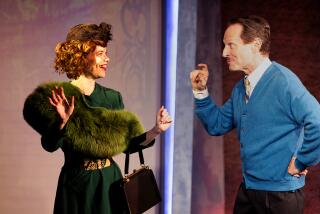1927 SCORE RECONSTRUCTED : MUSIC, DRAMA FUSED IN FILM OF PREWAR BERLIN
- Share via
To most Germanic scholars, the term Gesamtkunstwerk-- or, if you must, total artwork-- refers to Richard Wagner’s hoped-for fusion of romantic music and heroic drama. In the Germany of 1927, however, it meant something else, something related specifically to high-tech modernism, artistic experimentation and sociological revelation.
It meant a new kind of movie.
To the director Walther Ruttmann and the composer Edmund Meisel it meant the creation of an impressionistic documentary constructed on symphonic principles. It meant a marriage of sight and sound in which the music influenced the visual images just as the moving pictures stimulated the accompanying score.
The historic product of the Ruttmann-Meisel collaboration was “Berlin: Die Sinfonie der Grosstadt” (Berlin: The Symphony of a City). The original version lasted 78 minutes and enlisted an orchestra of 75. Sunday night at the Bing Theater of the County Museum of Art, Los Angeles was able to see a remarkable approximation of the original. It lasted about 65 minutes and enlisted a virtuosic orchestra of four--two pianos plus assorted percussion.
The superbly realized restoration entailed piecing together film fragments from archives around the world and, perhaps more complex, creating a new “sound track” with the aid of a primitive piano reduction. Meisel’s full score apparently did not survive World War II.
Although “Berlin” is based on an engaging script idea by Carl Mayer, it has no story. With a selective, often poetic, sometimes brutal eye, it merely records the first somnolent, then hectic, then somnolent action of a prosaic day in a European capital.
The action is impelled by trains and subways, by rush-hour traffic on streets and in restaurants and in cabarets, by the flow of rivers and sewers, by sunshine and rain, by the wonders of light-bulb factories and dish-washing machines, by street crowds and amateur athletes and even by animals in the zoo.
Karl Freund’s camera work, brilliant by any temporal standard, would make the film fascinating even if one had to watch it in silence. But Meisel’s music, lovingly arranged by Guenther Becker and Emil Gerhardt under the supervision of Lothar Prox, adds extraordinary dimensions of pathos, tension and wit.
Meisel--best known, perhaps, for his score for “Potemkin”--doesn’t just offer impressions of morning, noon and night in Berlin. He doesn’t just imitate sound effects and crank out superficial emotional reinforcement. He creates a bona-fide symphonic structure that allows the development of strikingly original materials in a strikingly sophisticated manner.
He makes telling use of broad Leitmotifs: a stark and unmistakable Berlin theme, a bittersweet noon-time chorale, an ironic workers’ march. He plays subtle games with mercurial tempos and compulsive rhythms--fascinatingly different ones to suggest the bustle of the mob, the frenzy of sport and, yes, the chugging of a steam engine. (“Pacific 231,” anyone?)
He isn’t afraid of stark dissonance. He likes tone clusters. He knows when and how to quote jazz rituals with tongue more or less wedged in cheek. He deals in abstract atmosphere as much as in literal translation. Even with his presumably colorful creation reduced to a black-and-white reproduction, he emerges as a forward-looking master of his craft.
For the Los Angeles revival, an installment in the imaginative Berlin Exiles series, Mark Andreas Schlingensiepen did what he could to make his four-piece ensemble sound like a whole orchestra and achieved miracles of synchronization with the amazingly pristine images on the screen.
“Berlin,” which attracted an enthusiastic full house as well as a long line of unhappy would-be ticket buyers, was presented by the museum in conjunction with the Goethe Institute, the city of Berlin (one of our many civic sisters) and the Stiftung Deutsche Kinemathek.
More to Read
The biggest entertainment stories
Get our big stories about Hollywood, film, television, music, arts, culture and more right in your inbox as soon as they publish.
You may occasionally receive promotional content from the Los Angeles Times.










